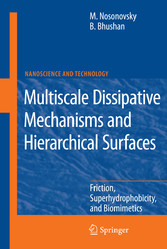Suchen und Finden
Mehr zum Inhalt

Multiscale Dissipative Mechanisms and Hierarchical Surfaces - Friction, Superhydrophobicity, and Biomimetics
Preface
6
Contents
8
Nomenclature
14
Glossary
16
Abbreviations
18
Part I Surface Roughness and Hierarchical Friction Mechanisms
21
1 Introduction
22
1.1 Surfaces and Surface Free Energy
22
1.2 Mesoscale
24
1.3 Hierarchy
26
1.4 Dissipation
26
1.5 Tribology
28
1.6 Biomimetics: From Engineering to Biology and Back
30
2 Rough Surface Topography
32
2.1 Rough Surface Characterization
32
2.2 Statistical Analysis of Random Surface Roughness
36
2.3 Fractal Surface Roughness
39
2.4 Contact of Rough Solid Surfaces
42
2.5 Surface Modi.cation
44
2.6 Summary
45
3 Mechanisms of Dry Friction, Their Scaling and Linear Properties
46
3.1 Approaches to the Multiscale Nature of Friction
47
3.2 Mechanisms of Dry Friction
50
3.3 Friction as a Linear Phenomenon
59
3.4 Summary
64
4 Friction as a Nonlinear Hierarchical Phenomenon
66
4.1 Nonlinear Effects in Dry Friction
66
4.2 Nonlinearity and Hierarchy
72
4.3 Heterogeneity, Hierarchy and Energy Dissipation
74
4.4 Mapping of Friction at Various Hierarchy Levels
80
4.5 Summary
81
Part II Solid–Liquid Friction and Superhydrophobicity
83
5 Solid–Liquid Interaction and Capillary Effects
84
5.1 Three Phase States of Matter
84
5.2 Phase Equilibrium and Stability
86
5.3 Water Phase Diagram at the Nanoscale
88
5.4 Surface Free Energy and the Laplace Equation
91
5.5 Contact Angle and the Young Equation
92
5.6 Kelvin’s Equation
95
5.7 Capillary Effects and Stability Issues
96
5.8 Summary
98
6 Roughness-Induced Superhydrophobicity
100
6.1 The Phenomenon of Superhydrophobicity
100
6.2 Contact Angle Analysis
104
6.3 Heterogeneous Surfaces and Wenzel and Cassie Equations
105
6.4 Calculation of the Contact Angle for Selected Surfaces
115
6.5 Contact Angle Hysteresis
126
6.6 Summary
131
7 Stability of the Composite Interface, Roughness Optimization and Meniscus Force
134
7.1 Destabilization of the Composite Interface
134
7.2 Contact Angle with Three-Dimensional Solid Harmonic Surface
145
7.3 Capillary Adhesion Force Due to the Meniscus
153
7.4 Roughness Optimization
156
7.5 Effect of the Hierarchical Roughness
160
7.6 Summary
170
8 Cassie–Wenzel Wetting Regime Transition
172
8.1 The Cassie–Wenzel Transition and the Contact Angle Hysteresis
172
8.2 Experimental Study of the Cassie–Wenzel Transition
176
8.3 Wetting as a Multiscale Phenomenon
182
8.4 Investigation ofWetting as a Phase Transition
184
8.5 Reversible Superhydrophobicity
185
8.6 Summary
185
9 Underwater Superhydrophobicity and Dynamic Effects
188
9.1 Superhydrophobicity for the Liquid Flow
188
9.2 Nanobubbles and Hydrophobic Interaction
190
9.3 Bouncing Droplets
191
9.4 A Droplet on a Hot Surface: the Leidenfrost Effect
194
9.5 A Droplet on an Inclined Surface
195
9.6 Summary
196
Part III Biological and Biomimetic Surfaces
199
10 Lotus-Effect and Water-Repellent Surfaces in Nature
200
10.1 Water-Repellent Plants
200
10.2 Characterization of Hydrophobic and Hydrophilic Leaf Surfaces
203
10.3 Other Biological Superhydrophobic Surfaces
216
10.4 Summary
216
11 Artificial (Biomimetic) Superhydrophobic Surfaces
218
11.1 How to Make a Superhydrophobic Surface
220
11.2 Experimental Techniques
225
11.3 Wetting of Micro- and Nanopatterned Surfaces
227
11.4 Self-cleaning
246
11.5 Commercially Available Lotus-Effect Products
247
11.6 Summary
248
12 Gecko-Effect and Smart Adhesion
250
12.1 Gecko
250
12.2 Hierarchical Structure of the Attachment Pads
252
12.3 Model of Hierarchical Attachment Pads
255
12.4 Biomimetic Fibrillar Structures
256
12.5 Self-cleaning
258
12.6 Biomimetic Tape Made of Arti.cial Gecko Skin
259
12.7 Summary
260
13 Other Biomimetic Surfaces
262
13.1 Hierarchical Organization in Biomaterials
262
13.2 Moth-Eye-Effect
263
13.3 Shark Skin
265
13.4 Darkling Beetle
265
13.5 Water Strider
266
13.6 Spider Web
266
13.7 Other Biomimetic Examples
267
13.8 Summary
268
14 Outlook
270
References
274
Index
290
Alle Preise verstehen sich inklusive der gesetzlichen MwSt.







